Valve opened up general availability of the Steam Deck in October last year, and being a gamer, I immediately rushed out to buy one. I loved it, but with a wave of other, more powerful handhelds flooding the market shortly after, the gaming handheld market suddenly heated up. The Steam Deck is undoubtedly one of the best gaming handhelds out there though, and the Steam Deck OLED is every bit as good as its predecessor and then some.
If you’re looking for a gaming handheld but aren’t sure what to get, the Steam Deck OLED is one of the best options available. With a fantastic screen, great performance, and notable improvements, this is the gaming handheld to get for most people. It’s that good, and if you’re looking for any Christmas gifts especially, then the OLED is one that I’d highly recommend.
About this review: Valve sent me the Steam Deck OLED for the purposes of this review on November 27th, 2023. Valve had no input into the contents of this review.

Steam Deck OLED
The upgraded Steam Deck with an OLED screen is more than just a screen upgrade. It has faster RAM, HDR support, and has up to 1TB of storage. Valve has set the bar yet again with a fantastic gaming handheld.
Dimensions
298mm x 117mm x 49mm (11.7 x 4.6 x 1.9 inches)
Brand
Valve
Weight
640 grams
Chipset
6nm AMD APU CPUL Zen 2 4c/8t, 2.4-3.5GHz (up to 448 GFlops FP32)
RAM
16GB LPDDR5 6400MT/s
Storage
512GB or 1TB NVMe SSD, microSD card slot
Wireless Connectivity
Tri-band Wi-Fi 6E radio, Bluetooth 5.3
Display
7.4-inch OLED 1280 x 800 x RGB with HDR support
Ports
USB-C (with DisplayPort over USB support)
Battery
50Whr battery with 3-12hrs of use
Pros
- New and improved OLED screen
- Same great speakers
- More battery efficient
Cons
- No performance improvements (aside from thermals)
Steam Deck OLED Price & Availability
The Steam Deck is only available through the Steam platform or website. There are two models available for the Steam Deck OLED, one with 512GB of storage at $549 and one with 1TB storage, and an anti-glare screen at $649. The 64GB and 512GB versions of the regular Steam Decek have been entirely discontinued. All versions come with a carrying case.
Design & build quality
Nothing out of the ordinary
The Steam Deck OLED is more or less the same as last year’s model when it comes to design and build quality, with the only significant change being in the display. It jumps from a 7-inch display to a 7.4-inch display and is an OLED panel with HDR support and a refresh rate of 90Hz. Aside from that, the rest of the device is mostly the same, with the power button turning red and the joysticks being completely black, rather than gray and black. Finally, the haptics are improved a little bit, too.
Just like that, though, the same critiques I had of the Steam Deck are still here as well. It’s pretty bulky, and if you’re putting it in something like a backpack, it’ll take up a lot of space. Smaller devices like the Asus ROG Ally might be more up your alley as a result of that, as it really is just massive in comparison.
Aside from being large and bulky, the Steam Deck OLED makes good use of that space. It boasts two analog sticks, a D-pad, two thumbsticks with integrated capacitive touchpads, two independent touchpads, four A/B/X/Y buttons, four shoulder triggers, a prominent Steam button, a three-dot button for accessing additional Steam OS options within games, and four remappable back paddles. Notably, the touchpads serve as additional buttons, and in compatible applications, selective presses on specific areas trigger enhanced options. Additionally, there are two volume buttons, a top-mounted headphone jack, a USB-C port, and a microSD card slot.
I’ve found that a lot of games now use the remappable controls on the back, such as Half-Life. They can be a little bit finicky to use consistently, and I find myself in difficulty trying to keep them pressed at any given time. For example, they’re used for crouching in Half-Life, and I’ve accidentally let go of the button several times now because of how difficult it can be to keep it held down for long.
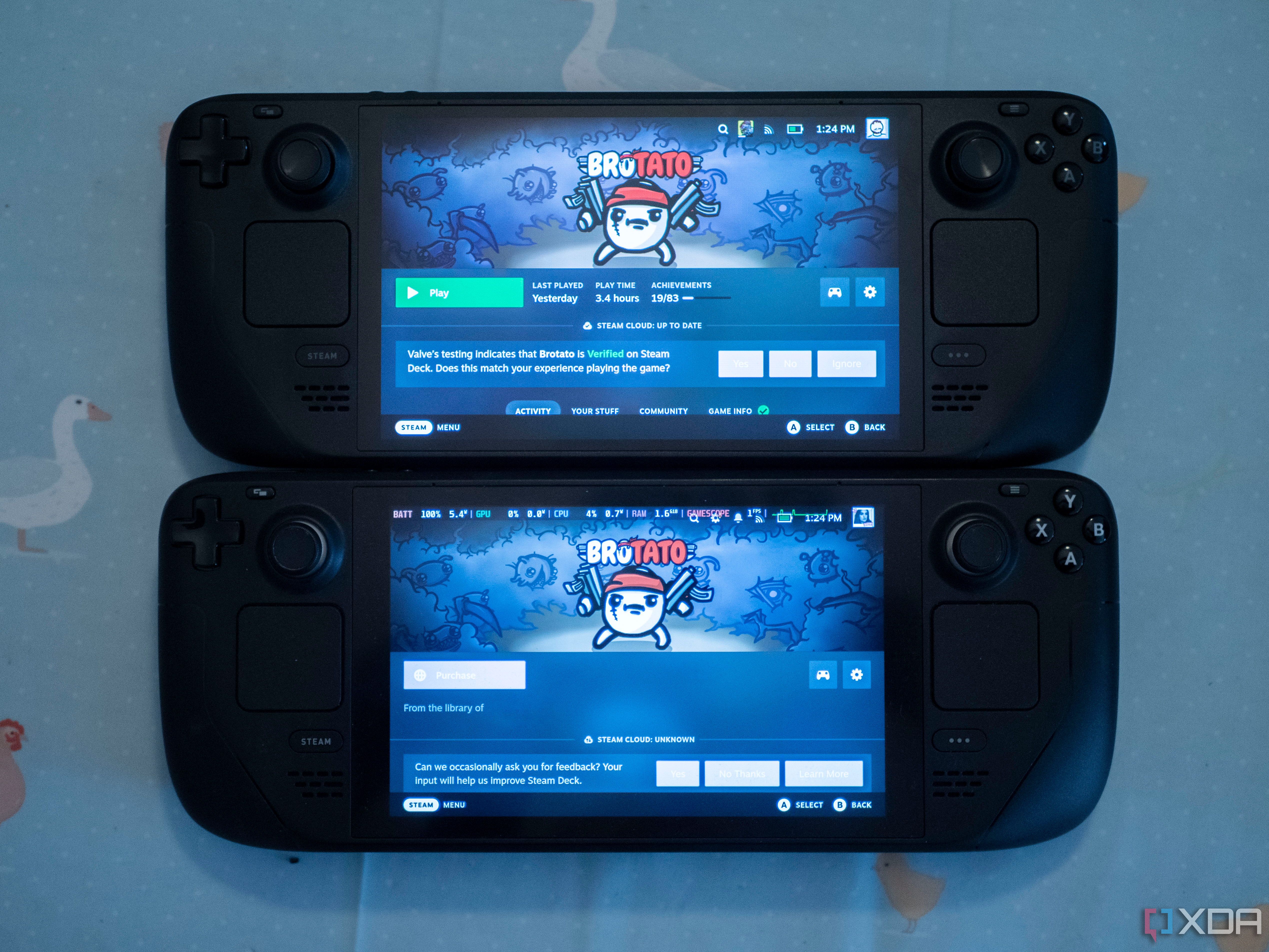
Top: Steam Deck OLED // Bottom: Steam Deck LCD
The 1280×800 7.4-inch OLED HDR touchscreen is a massive improvement and looks great in many games like Hades and Cyberpunk: 2077. We have the 1TB model with an anti-glare coating on the screen, and it’s also a bit brighter than the original Steam Deck. I used the OLED model while traveling recently on a train and with the sun shining directly on it, I could still see what was happening so that gets a thumbs up from me.
To make things even better, the colors also look great on the OLED model, and the screen gets a bit brighter, too. The higher refresh rate is a welcome upgrade too, and 90Hz is a good sweet spot between the high refresh rate options like the Legion Go and the Asus ROG Ally and the normal 60Hz options like the regular Steam Deck. Older games or indie titles are a lot more likely to hit this 90Hz sweet spot, and games like Hades look fantastic and feel great because of it.
The OLED HDR touchscreen is a massive improvement
The USB-C port is bottom-facing and charges at 45W over USB-PD, but it would have been nice to have a second one (which many handhelds like the Ayaneo Kun and the Lenovo Legion Go have also done) so that a USB-C to DisplayPort cable and charger could be connected at the same time. Any of the best Steam Deck docks can get around this, though.
Finally, the Steam Deck’s speakers are just as good as the original, being nice and loud and some of the best in any of the gaming handhelds released so far. I’m really a big fan of these and how they’ve managed to stay at the top all this time.
Performance
Cyberpunk: 2077, Spider-Man: Miles Morales, Ratchet & Clank: Rift Apart

We first tested a couple of high-tier titles that we expect people will want to play on the Steam Deck OLED the most, and these were Cyberpunk: 2077, Spider-Man: Miles Morales, and Ratchet & Clank: Rift Apart. All three of these games are Steam Deck verified, and as such, should perform well.
First up with Cyberpunk: 2077, we analyzed its performance while running the game’s built-in benchmark. This should serve as a good representation of what to expect when playing through the game and also allows us to easily compare to other handhelds on the market.
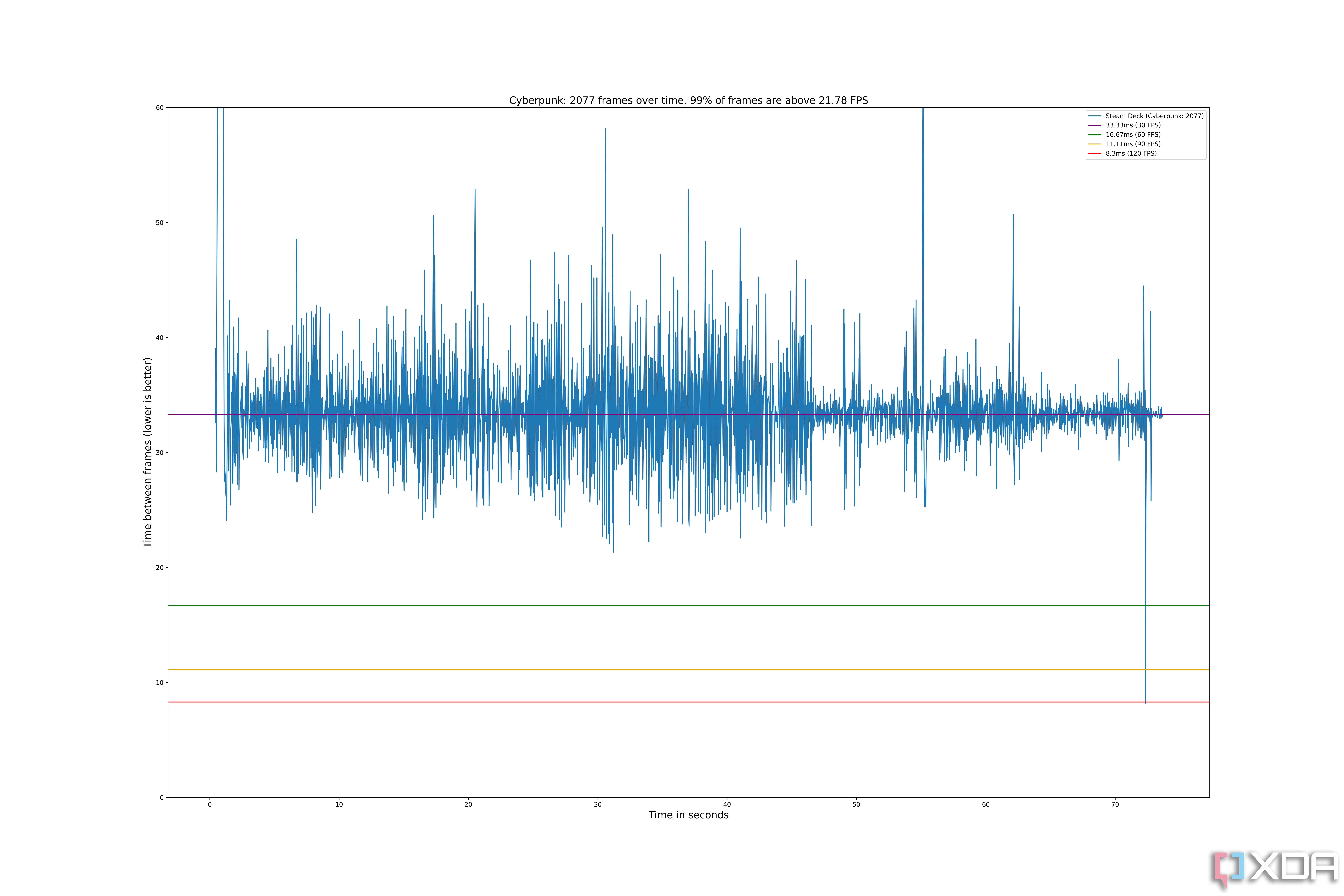
Interestingly, Cyberpunk runs nearly perfectly, more or less locking in 30 FPS. 99% of the time you can expect to experience at least 22 FPS, and even the lowest frame times will see you still playing at 12 FPS. Those times are exceptionally rare too. This is a pretty stable performance, and on average, you’ll experience 30 FPS.
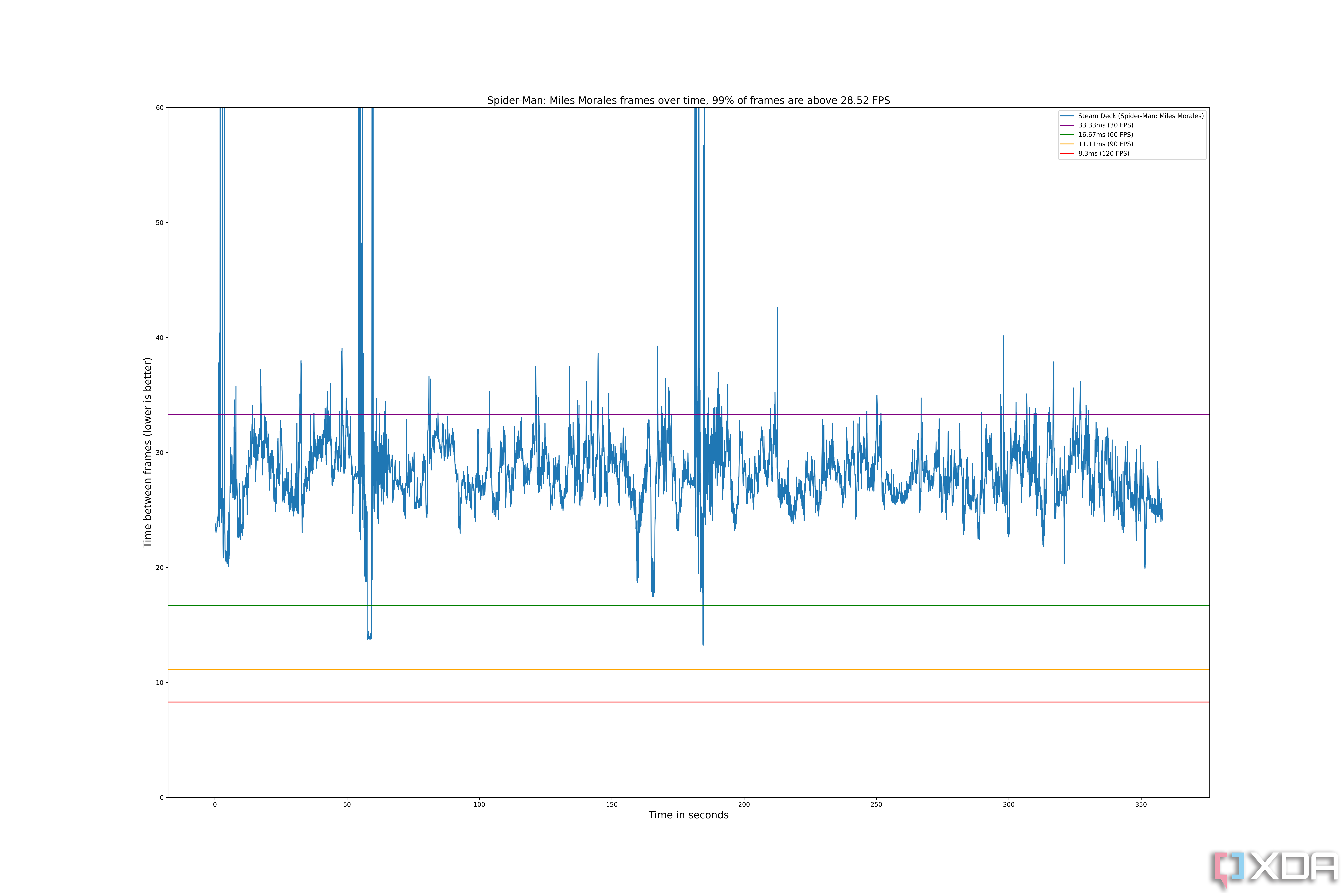
Next up is Spider-Man: Miles Morales. The above was recorded during one of the final fight scenes of the game, with many NPCs shooting and fighting. This is a great score, and again, appears quite consistent with players experiencing 29 FPS or higher 99% of the time.
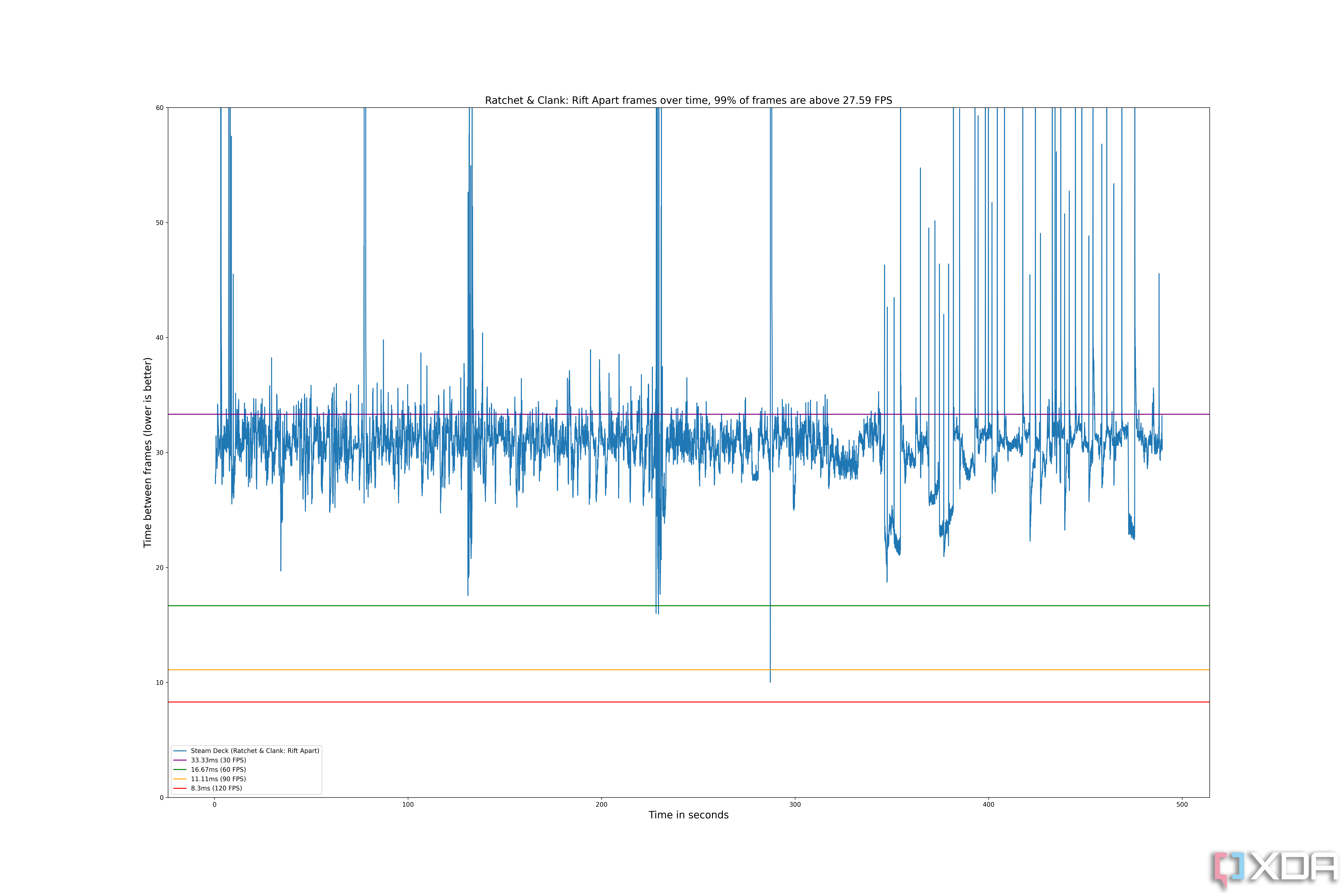
Finally, Ratchet & Clank: Rift Apart performed quite well, too. You can also expect 30 FPS gameplay most of the time, and that’s more than good enough for stock settings out of the box on a handheld gaming console.
The Steam Deck is easy to use and works for just about everyone, and that’s what most people care about
To be clear, you’ll probably net better performance in all of these games on competing products from the likes of Asus and Ayaneo, but that’s not the point. The Steam Deck is easy to use and works for just about everyone, and that’s what most people care about. These results are fantastic in a vacuum of being a handheld console capable of major titles.
If you’re worried about whether a game will run on your Steam Deck, you can keep a look out for the Verified on Deck badge. It’s a badge that games can get on Steam that signals if it runs well on the Steam Deck. A ton of games nowadays are supported on Steam Deck, and it’s a great indicator of what you can and can’t play.
If you want to play with plugins, then you can install a plugin that will show you the ProtonDB score for any particular game in your library. Otherwise, you can use the website and you can even link your Steam account to it to find games in your library that are playable. I found a few games that way that I wouldn’t have thought to play otherwise. The Steam Deck is basically just a laptop running Arch, meaning that you can install whatever you want on it including any free games you got on Epic.
Battery life and thermals
Valve has said that the Steam Deck OLED has a 25% larger battery and a 6nm AMD APU versus the 7nm of the Steam Deck LCD. That means better battery life on account of a physically larger battery and better thermals on account of a more efficient chipset. With both of those combined, I am seeing crazy good battery life across the board. I’ve been playing games like Brotato, Hades, and Half-Life, and I’m seeing battery life that will last hours upon hours on a full charge. The Steam Deck said that, for example, I would see nine hours of playtime in Half-Life. It’s an easy game to run, but that’s still absolutely absurd to think about.
This is a major win from Valve and solidifies the Steam Deck as one of the best in the business.
Thermals-wise, even in Cyberpunk: 2077 the handheld’s thermal management is impressive, and there aren’t any problems when playing with it for long periods of time, unlike on the Ayaneo 2S which can get quite hot around the screen. This is a major win from Valve and solidifies the Steam Deck as one of the best in the business.
Steam Deck OLED: Should you buy it?
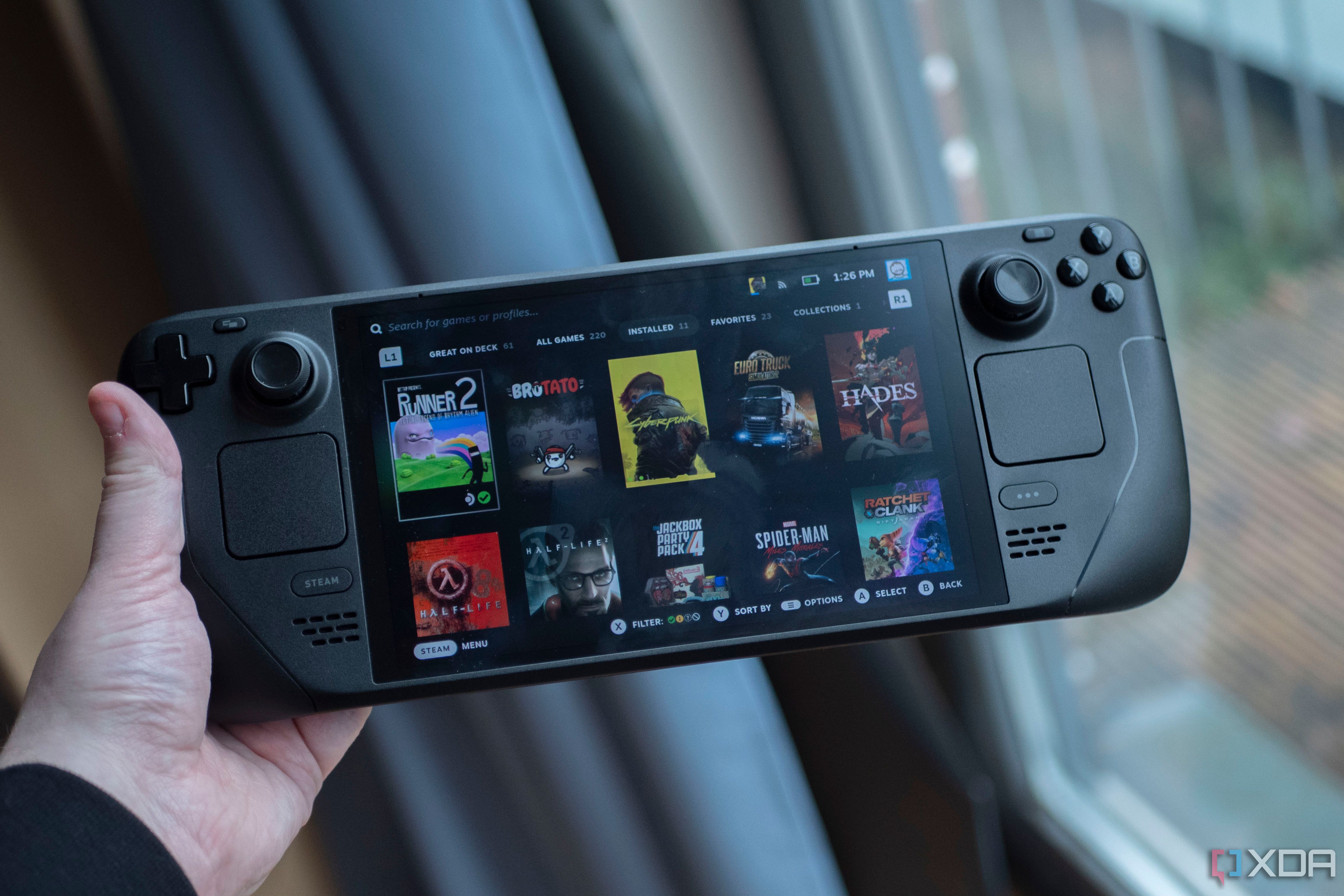
You should buy the Steam Deck if:
- You want to play PC games away from your PC
- You like having control over your game settings
- You especially like to play indie titles
You shouldn’t buy the Steam Deck if:
- You don’t want a big handheld
- You want to do intensive emulation or don’t like working on Linux
- You have the original Steam Deck
The Steam Deck OLED takes the original Steam Deck and makes some massive improvements across the board, improvements that weren’t even necessarily needed. OLED was always going to be a nice addition, but I think most people would have been happy to accept that for the Steam Deck 2 a few years down the road. Other changes, like a node shrink for the APU, more storage, and better RAM are great improvements, but ones that were definitely not necessary in an OLED switch-up. If Valve had released the OLED with all of the same qualities as the original Steam Deck (but with a better screen), then there would still have been happy people.
I think that Valve has just set the bar yet again.
The Steam Deck OLED is worth every cent you spend on it, and for people who have the LCD, you probably don’t need to upgrade. If you have the option of an LCD or an OLED model though, you should 100% get the OLED model even if it costs you more. The original LCD Steam Deck will be available for purchase in abundance on the re-sale market, and to be honest, if you have an LCD and are eyeing up the OLED, that mightn’t be a bad way to fund your new purchase.
Either way, the Steam Deck OLED closes out 2023 with a bang, and with another year of gaming handhelds on the horizon, I think that Valve has just set the bar yet again.
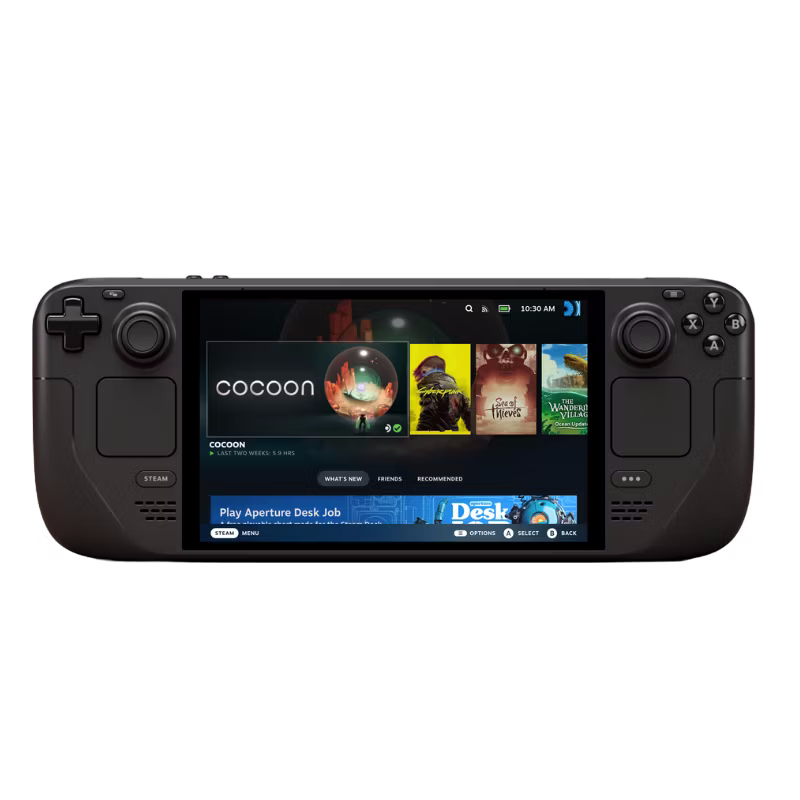

Steam Deck OLED
The upgraded Steam Deck with an OLED screen is more than just a screen upgrade. It has faster RAM, HDR support, and has up to 1TB of storage. Valve has set the bar yet again with a fantastic gaming handheld.
Dimensions
298mm x 117mm x 49mm (11.7 x 4.6 x 1.9 inches)
Brand
Valve
Weight
640 grams
Chipset
6nm AMD APU CPUL Zen 2 4c/8t, 2.4-3.5GHz (up to 448 GFlops FP32)
RAM
16GB LPDDR5 6400MT/s
Storage
512GB or 1TB NVMe SSD, microSD card slot
Wireless Connectivity
Tri-band Wi-Fi 6E radio, Bluetooth 5.3
Display
7.4-inch OLED 1280 x 800 x RGB with HDR support
Ports
USB-C (with DisplayPort over USB support)
Battery
50Whr battery with 3-12hrs of use
** (Disclaimer: This video content is intended for educational and informational purposes only) **
More...

